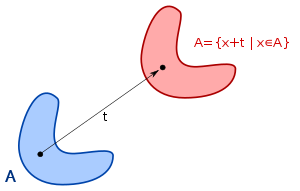Translational invariance
As translationally invariant in are mathematics figures referred whose value is derived from a translation does not change. More specifically, means a functional translation-invariant, when the value of the functional does not change when the function of a translation with displacement vector is subjected: .
For example, every constant function is translation invariant. A more interesting example is the Lebesgue integral . Its translation invariance clearly means that the value of an integral does not change when the domain of definition is shifted, just as the volume of a body does not change through pure displacement in space.
General definition: translational invariance in groups
More generally, it is possible to define translation invariance in group operations. Let X a set with a transitive operation of a group G . Then induced
for each element g of G an automorphism of X and thus an automorphism on each functorial structure F (X) on X . The G invariants in F (X) are called translation invariant.
For a group G and X = G one can through
- and
Define two G-spaces, the associated translation invariance is called left or right invariance.
For example, the Lie algebra of a Lie group is the space of the left invariant vector fields . A Haar measure on a topological group is also translation-invariant. The Petersson scalar product on the upper half-plane is defined with the help of an SL (2, R) -invariant measure.
Others
Translation invariant is also a stochastic function that is only changed by additive (or subtractive) components. The laws that are described with the function are not affected. Only the mean or scale values change.
literature
- Otto Forster : Analysis. Volume 3: Measure and integration theory, integral theorems in R n and applications , 8th improved edition. Springer Spectrum, Wiesbaden, 2017, ISBN 978-3-658-16745-5 .
- Konrad Königsberger : Analysis 2 , Springer, Berlin 2004.










